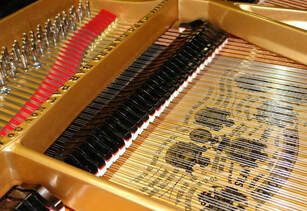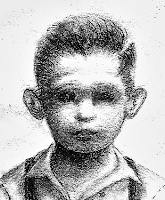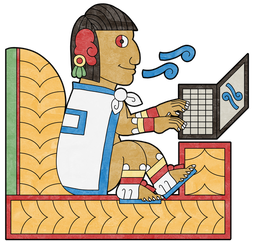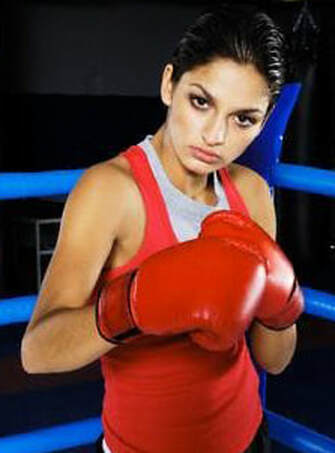Chicano ConfidentialBy Sonny Boy Arias I was attending a professional academic conference on the topic of the “psychology of the Self” that was interdisciplinary in nature, being held at the Marriot Hotel in Orange, California, not far from John Wayne International Airport. Upon arrival at the Marriott, I noticed that the hotel service workers were all very busy attending to multiple activities, a business conference, an afternoon meeting of the Lions’ Club, our academic conference, and, to my pleasant surprise they were setting up for an evening of pugilism, you know, good old-fashioned fighting, punching, hitting and, if we’re lucky, maybe some head butting. It was going to be an evening full of professional boxing and guess what? The “card” included women’s boxing! Yahoo! To say the least, the hotel was “buzzing.”As I entered the front door of the hotel I was not yet into the lobby when I was greeted by a large aquarium-like water dispenser stock full of fresh lemons located in the vestibule, the interstitial zone, the area between the front door and the lobby, the “in between,” a place where symbolically, I love to be and that most people find uncomfortable. So looking up to the morning sunlight, I closed my eyes and took a drink of the lemon water only to be disrupted by a pair of academics (you know the snooty types) speaking poorly of the age-old sport of boxing as well as those who attend boxing matches. “Can you imagine entering a ring with the objective to beat each other’s brains out?” one said, and the other replied, “What sort of people would attend such an event?” And then it occurred to me, these chaps were in attendance at the conference I came to attend. I also realized that I would much rather be at the boxing match. I was reminded of how many years I tried to develop of my academic colleagues as boxing buffs, but to no avail as they all looked down their noses at the sport I so well loved. As a result my enthusiasm was driven underground and I had to watch boxing events at home by my lonesome. I have to admit that the reason I like hanging out in the vestibule (interstitial zone) is because others always hurry through so I felt like I had the specially made water all to myself, it was a space where I could temporarily seek refuge from the morning hustle-and-bustle I experienced at two airports and a quick taxicab ride. As I drank the cool water I was reminded of a going away gift a friend once gave me the day prior to departing Texas for California: a water dispenser just as large as the one I was presently faced with and filled with several rows of pineapple and, need I say, vodka, seven times distilled. Thing is, because we were leaving the next day we had to drink the whole thing. There too rests a dichotomy as my academic colleagues were either non-consumers of alcohol or alcoholics. The unspeakable truth is that many of them stashed bottles of whisky in their university office files alongside their winter breath mouthwash to disguise the smell of alcohol. University professors are a “walking contradiction” in this way, always preaching one thing and doing something else. Concomitantly, we are trained to search for the truth in our subject matter and we always land-up masking our findings with illusions of the truth. In the “interstitial zone of life” you might say, you are neither here nor there but you are always discovering something new. As I looked around the hotel I noticed to my right, a sign-up table for my conference; it looked drab, and the people staffing the table looked just as drab, just like the stuffed shirts academics I knew I would meet up with later in the afternoon, so rather than sign-up for the conference I decided that it could wait so I immediately went to the left to the hotel registration desk, signed into my room and proceeded to the gym for a quick workout. The gym was average in size (not bad) and had some of the best equipment I had ever seen at a hotel gym, complete with treadmills with fans, widescreen television sets and what looked like an “aquarium” filled with fresh cut lemons and cool drinking water just like the one located in the vestibule near the front door of the hotel. I mounted the treadmill, set the fans on high and rapidly worked up to a good self-paced jog for twenty-minutes. I was set to leave and started pouring lemon water when as if out of nowhere a female boxer walked into the gym. She had a long black pony tail, was very fit, and had the appearance of a Chicana Hilary Swank in the fight movie “Million Dollar Baby” produced by Clint Eastwood. She wore a bright red robe with matching red Everlast boxing gloves and there were large silver letters across her back that read, “Tap Out, San Antonio.” I later learned that this was the name of her boxing gym. In a very nervous manner, she looked me straight in the eye and asked me how my workout was going. As I drank the cool lemon water she began to nervously shadow box all about the gym. I asked her if she was from San Antonio and let her know that I was living in Kingsville, Texas (just south of San Antonio). At this, she made direct eye contact and in a heavy Chicano accent told me about how this was her first time in “Loz Angeles.” She went on to say that she had come a long way to fight a well-known boxer (undefeated) from Los Angeles and that this was the biggest fight of her career with 8 wins, 1 knockout and 0 losses. She said that she was nervous and “a little afraid.” I told her that I loved boxing, had boxed as a young man for the Boy’s Club of San Diego, undefeated for two years and that I had often reflected upon my feelings of fear (when first entering the ring) but had come to a point of enjoying the feelings of fear; especially once I demonstrated some boxing competency to myself. Besides a good dose of adrenaline does the body good! I added that I had employed this strategy throughout my life and that today in my capacity as a social psychologist had come to inculcate this behavior in everyday life. In other words, I overcome fear by “diving straight into it,” the phenomenon that is causing the fear in the first place, that is, and always find that by doing so this method can assist with the fear factor. She caught my eye again and said she had earned a degree in psychology and business at the downtown San Antonio satellite campus of the University of Texas; I had once consulted there for start-up development. She did not work out long as it appeared that she had some nervous energy to keep in check. As she worked the stair-stepper, she jabbed into the air as professional boxers often do. After ten minutes or so her manager came by, knocked on the window and just before exiting the gym, she turned and invited me to the fight. I told her I would be there “in her corner.” Now that I think about it, I noticed that she had a quick conversation with her manager, pointed to me, and left the hallway. After my workout, I took a shower and tried to psyche-up for conference mode. I walked through the “buzz” generated by hotel personnel and signed-up for my conference at the conference desk with a rather bored looking woman who afforded me a mountain of materials along with a sizeable name tag and one-hundred percent cotton bag made by some poor kid working out of a sweatshop in Bangladesh. Now that I was all “labeled” up, I could identify myself with several hundred other colleagues all walking around the hotel aimlessly or talking on their cell phones acting as if what they were talking about was somehow important. As I sat through the conference workshops that morning I made it a point to get up and walk the hallways of the hotel about every forty minutes. Frankly, I did so mostly out of boredom (I just have to be honest with you), to get some exercise and also to pee as I was on “pee pills” as part of my kidney stone regimen. Our conference was being held on the furthest side opposite the front door of the hotel, maybe some fifty yards away. In between our conference room and the front door was a very large hall where the evening fights were going to be held that looked like it could fit up to 2,000 people; it actually looked like a ballroom. There were any number of vendors, service and lighting people, and professional boxing types everywhere. I must say this certainly made my trips to the restroom quite interesting. As I walked the hallways of the hotel I kept asking people where I might purchase a ticket for the fights. Well, it soon became common knowledge that the fight was sold out. I understood this but I kept asking anyway and felt that the $28 dollar investment would be well worth it and at the same time give me an excuse not to hang-out with the stuff-shirt academics who only wanted to talk about their boring work. In search of tickets I happened to meet the promoter of the fights near the giant Tecate beer bottles being set up near the main bar. He acted busy so I was surprised he gave me a few minutes of his time as I asked him a number of questions, like how many fights were there going to be, who was fighting and the like. After this conversation I noticed a guy who looked like a “ticket scalper” and asked him if he had tickets; he did not, but he did encourage me to keep checking with him and I heard him on his cell phone trying to locate a ticket for me, these were all good signs and at the same time reified in me my tenacious behavior. Later that day, on another trip to the restroom I noticed some people wearing “Tap Out” shirts setting up a booth with pictures of what looked like the female boxer I had met in the gym. A young woman (that looked like the boxer’s sister) said I had to go to the fight to watch “Norma kick some ass.” I found her confidence contagious and even a little intimidating and agreed. Just as she directed me to purchase a $9 picture with “Norma Cha Boom Boom” she (Norma) came around the corner out of the staging room, how could I refuse to purchase a picture? The camera was not yet set-up, but the “sister” gave me the “look” as if to say “Why not just purchase one of these pictures asshole we need the money” so I placed the $9 in the plastic jar, said a few encouraging words to Norma and decided to walk through the “staging room” where both male and female boxers were hanging their garments, taping-up their hands and getting ready to mostly kill time by shadow boxing and of course to “talk shit” about their opponents. I could tell that “Norma Cha Boom Boom” was real tough, a street fighter who rest assured could take a lot of pain and give some, too. My sense is that she is probably a better fighter with her gloves off and out of the ring on the street some fighters are just that way, hence, they might lose in the ring, but they will always win a fight on the street. The paradox is simply there are far too many rules to follow in the ring it’s not like back in the day. Each boxer had a very small area in this large room where they would prepare themselves for the fight, there were both male and female boxers, their managers and their “handlers” just like the ones I had just met selling pictures. I was now an official “Norma Cha Boom Boom fan” and was determined to go to the fights that evening. I returned to my academic conference and found a speaker, a professor of rhetoric from the University of Pennsylvania, preparing to give his lecture. I also noticed a number of copies of a very thick book (over 500 pages) placed at every table. It was a book written by the speaker (“good old what’s his name) and the subject matter was “self-development for adult learners.” Anyway I sat about three tables down from the podium where he was addressing over 300 academics from a variety of disciplines. At one point he conducted an exercise asking every table in the room to meet for a few minutes and come up with a definition of the word “plisky.” Beyond working in collaboration with others, I am not sure what the point of the exercise was, but the speaker made it a point to tell the audience that he had spent two hours trying to identify a word that “this group” (Ph.D.’s) might not know the definition, so each table came up with a definition, presented it to the greater group, and by a show of hands, each respective definition was either accepted or rejected by the entire group of 300. It didn’t take long to reject a number of excellent definitions. At our table, like all of the other tables, no one was forthcoming with a “true” definition. As a group we lacked vibrancy and imagination, the exercise was suddenly boring and uneventful. Even though I was not feeling it and didn’t really care to collaborate with others at my table (as I was busy trying to figure out how to get a ticket to the fights), I shared my knowledge of a “plisky” and told them how I knew what it was. This is what I shared. While serving as a Dean of the College of Arts and Sciences at Texas AandM University, I told them, I once proposed to the Chancellor’s Office that we fund a Center of Excellence every two years. The Chancellor thought this was a “great idea,” funded our university, and as a result we competed for the prize within our own university. I reflected upon the “excellence” I found in each of my 18 departments and ascertained a need for a grand Steinway piano in the Music Department. I was convinced that the only way we would attract top artists was if we had a Steinway, as artists will often not provide a concert without a Steinway or Kawai piano. So I met with the chair of the Music Department with the idea of writing a proposal for this purpose. He told me that he loved the idea but had never written a proposal. At this, I told him I would write the proposal on his behalf as long as he didn’t tell the other chairs that I had done so; since I could not focus in my Dean’s Office I set up a time to visit the Music Department to find a place to write. The chair took me into a piano room with no windows but with a few hundred boxes of old sheet music that smelled like musty paper and a very old Bösendorfer grand piano (a unique prototype made in Vienna) stacked high with even more sheets of music. Suddenly, without warning he stretched his arm out across the top of the piano and moved it rapidly from one end to the other, clearing everything atop the piano to the floor; “now you have work space,” he blurted, smiled, and walked away. It took me about three hours to write the proposal that was subsequently funded for around $700,000. Again, it was the first award in the Texas AandM University System of its kind. I had proposed it, and I was proud of the fact that it was awarded to our Music Department. With a sizeable check in hand I immediately made contact with the Steinway Piano Corporation in New York City and they in turn placed me in contact with their representative in their Houston corporate office. I was invited to the “Steinway showroom” in Houston. I must say that all of the Steinway people I had met were very professional. They began our meeting with champagne and a brief history of the Steinway piano. I learned that only a particular kind of wood from the Black Forest in Germany was used to make their pianos because it was that particular forest where the Steinway Family was having a picnic one afternoon when lightning struck, killing the entire family with the exception of one man who (at the time lightning struck) heard a significant tone (a reverberation of a sort) in the trees. It was that sound and that event that changed the life of young Steinway.  At the same time, Steinway pianos are known not to utilize wood glue to hold the pieces inside the piano together. Rather, the wood is placed in such a manner so as to hold itself together, using wooden doles and support design. At the same time, each piano key stretches from the front side of the piano (ivory key side) into the inside of the piano through an extended wooden arm, and at the end of the arm is a “hammer head” made of hardened felt – that is the “plisky.” A professor in the room (someone I had never met) reified my definition by adding that once he had worked for the Hammond Organ Company and that my definition was true. I think he was simply full of himself and wanted others to know that he had a life outside of academe. I successfully argued that the “plisky” was the part of the hammer made of hardened cotton that struck the piano string. The “plisky” is located beneath the black hammers in this picture, but of course my point is that it was not true, I was dreadfully bored and was looking for a cheap thrill, plus, I just wanted to be powerfully convincing and I was. Read on. The entire group of 300 cheered at my story and voted mine as the best definition of the word “plisky.” Fact is, when the speaker read the real definition of the word, “plisky,” no one believed him. He said that according to Webster’s Dictionary a “plisky” was a joke, something made up as when someone “kids around.” When I told the group that I had made up the definition they did not believe me! It took some re-explaining to undo as several of them became adamant and few were on to my boredom and trickery. Following the “plisky exercise,” I took a break and sought refuge in the hallways only to run into Norma, the female boxer. She said that the fighter she was originally matched-up with was a “no show” and that she would now be matched-up with “that girl over there,” a young woman dressed in “Irish greens” with red hair, big freckles, and bright green eyes who looked like she possessed a thick Irish accent and could hold her own in the ring, Norma sensed that the young woman was a “push over” and said as she shook her head, “Look at her, now what a plisky that is!”  Sonny Boy Arias, a dedicated contributor to Somos en escrito via his column, Chicano Confidential and a stone-cold Chicano, has been on hiatus while on a world tour of Europe and the Subcontinent telling stories. He writes under the general rubric of historias verdaderas mentiras auténticas–true stories and authentic lies. He has found this the most effective manner to convey his stories about Chicano life. Copyright © Arts and Sciences World Press, 2018.
0 Comments
Your comment will be posted after it is approved.
Leave a Reply. |
Archives
June 2024
Categories
All
|
Donate and Make Literature Happen
is published by the Somos En Escrito Literary Foundation,
a 501 (c) (3) non-profit, tax-exempt corporation. EIN 81-3162209



 RSS Feed
RSS Feed